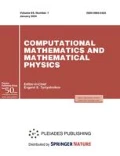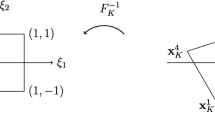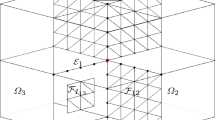Abstract
Techniques that improve the accuracy of numerical solutions and reduce their computational costs are discussed as applied to continuum mechanics problems with complex time-varying geometry. The approach combines shock-capturing computations with the following methods: (1) overlapping meshes for specifying complex geometry; (2) elastic arbitrarily moving adaptive meshes for minimizing the approximation errors near shock waves, boundary layers, contact discontinuities, and moving boundaries; (3) matrix-free implementation of efficient iterative and explicit–implicit finite element schemes; (4) balancing viscosity (version of the stabilized Petrov–Galerkin method); (5) exponential adjustment of physical viscosity coefficients; and (6) stepwise correction of solutions for providing their monotonicity and conservativeness.
Similar content being viewed by others
References
N. G. Burago and V. N. Kukudzhanov, “A review of contact algorithms,” Mech. Solids 40 (1), 35–71 (2005).
Methods in Computational Physics: Advances in Research and Applications, Vol. 3: Fundamental Methods in Hydrodynamics, Ed. by B. Alder, S. Fernbach, and M. Rotenberg (Academic, New York, 1964; Mir, Moscow, 1967).
Numerical Methods in Fluid Mechanics, Ed. by O.M. Belotserkovskii (Mir, Moscow, 1973) [in Russian].
O. M. Belotserkovskii and Yu. M. Davydov, Large-Particle Method in Gas Dynamics (Nauka, Moscow, 1982) [in Russian].
S. K. Godunov and G. P. Prokopov, “The use of moving meshes in gas-dynamical computations,” USSR Comput. Math. Math. Phys. 12 (2), 182–195 (1972).
V. M. Kovenya and N. N. Yanenko, Splitting Methods in Gas Dynamics Applications (Nauka, Novosibirsk, 1981) [in Russian].
L. V. Kruglyakova, A. V. Neledova, V. F. Tishkin, and A. Yu. Filatov, “Unstructured adaptive meshes for problems in mathematical physics,” Mat. Model. 10 (3), 93–116 (1997).
A. N. Gil’manov, Adaptive Grid Methods in Gas Dynamics Applications (Fizmatlit, Moscow, 2000) [in Russian].
G. P. Prokopov, Preprint IPM RAN (Keldysh Inst. of Applied Mathematics, Russian Academy of Sciences, Moscow, 2006).
V. D. Liseikin, “The construction of structured adaptive grids—a review,” Comput. Math. Math. Phys. 36 (1), 1–32 (1996).
S. A. Ivanenko, “Variational methods for adaptive grid generation,” Comput. Math. Math. Phys. 43 (6), 793–806 (2003).
V. G. Bazhenov, V. L. Kotov, and S. V. Zefirov, “Matching of various difference schemes in nonstationary continuum mechanics problems by the method of overlapping meshes,” Vestn. Nizhegor. Univ. Ser. Mekh. 7 (1), 134–140 (2006).
B. N. Azarenok, On Adaptive Moving Mesh Generation (Vychisl. Tsentr Ross. Akad. Nauk, Moscow, 2007) [in Russian].
Advances in Grid Generation, Ed. by O. V. Ushakova (Nova Science, New York, 2007).
A. V. Minakov, A. A. Gavrilov, and A. A. Dekterev, “Numerical algorithm for solving three-dimensional fluid dynamics problems with moving solid bodies and free surface,” Sib. Zh. Ind. Mat. 11, (4), 94–104 (2008).
V. N. Kukudzhanov, Numerical Continuum Mechanics (Fizmatlit, Moscow, 2008; Walter de Gruyter, Berlin, 2013).
V. D. Liseikin, Grid Generation Methods (Springer, Berlin, 2010).
N. G. Burago, “Formulation of basic equations for continuum mechanics in moving adaptive coordinates, in Numerical Methods in Solid Mechanics, Ed. by G. I. Pshenichnov (Vychisl. Tsentr Akad. Nauk SSSR, Moscow, 1984), pp. 32–49 [in Russian].
N. G. Burago and S. A. Ivanenko, “Application of elasticity equations to adaptive grid generation,” Proceedings of All-Russia Conference on Applied Geometry, Grid Generation, and High-Performance Computations, Moscow, Computing Center of the Russian Academy of Sciences, June 28–July 1, 2004, Ed. by V. A. Garanzha (Vychisl. Tsentr Ross. Akad. Nauk, Moscow, 2004), pp. 107–118.
A. N. Brooks and T. J. R. Hughes, “Streamline upwind Petrov–Galerkin formulation for convection dominated flows,” Comput. Methods Appl. Mech. Eng. 32, 199–259 (1982).
G. J. Le Beau, S. E. Ray, S. K. Aliabadi, and T.-E. Tezduyar, “SUPG finite element computation of compressible flows with the entropy and conservation variables formulations,” Comput. Methods Appl. Mech. Eng. 104, 397–422 (1993).
N. G. Bourago, A. I. Glushko, and A. N. Kovshov, “Thermodynamic method for constructing constitutive relations for models of continuous media,” Mech. Solids 35 (6), 1–9 (2000).
G. Strang and G. J. Fix, An Analysis of the Finite Element Method (Prentice Hall, Englewood Cliffs, N.J., 1973; Mir, Moscow, 1977).
N. G. Burago, “Modeling of elastoplastic fracture,” Vychisl. Mekh. Sploshn. Sred 1 (4), 5–20 (2008).
N. G. Burago and I. S. Nikitin, http://engjournal.ru/catalog/mathmodel/hidden/883.html
N. G. Burago, I. S. Nikitin, and V. L. Yakushev, “Numerical modeling of sintering of powder materials under moving laser actions,” Vestn. Kibern., No. 3, 12–23 (2014).
N. G. Burago and V. N. Kukudzhanov, “Numerical solution of elastic plastic problems by FEM: ASTRA software package,” in Computational Solid Mechanics (Nauka, Moscow, 1991), Vol. 2, pp. 78–122 [in Russian].
A. A. Samarskii and B. D. Moiseenko, “An economic continuous calculation scheme for the Stefan multidimensional problem,” USSR Comput. Math. Math. Phys. 5 (5), 43–58 (1965).
J. H. Wilkinson and C. Reinsch, Handbook for Automatic Computation, Vol. 2: Linear Algebra (Springer-Verlag, Berlin, 1971; Mashinostroenie, Moscow, 1976).
A. G. Kulikovskii, N. V. Pogorelov, and A. Yu. Semenov, Mathematical Aspects of Numerical Solution of Hyperbolic Systems (Fizmatlit, Moscow, 2001; Chapman and Hall/CRC, London, 2001).
E. P. Doolan, J. J. H. Miller, and W. H. A. Schilders, Uniform Numerical Methods for Problems with Initial and Boundary Layers (Boole, Dublin, 1980; Mir, Moscow, 1983).
Author information
Authors and Affiliations
Corresponding author
Additional information
Dedicated to the memory of O.M. Belotserkovskii
Original Russian Text © N.G. Burago, I.S. Nikitin, V.L. Yakushev, 2016, published in Zhurnal Vychislitel’noi Matematiki i Matematicheskoi Fiziki, 2016, Vol. 56, No. 6, pp. 1082–1092.
Rights and permissions
About this article
Cite this article
Burago, N.G., Nikitin, I.S. & Yakushev, V.L. Hybrid numerical method with adaptive overlapping meshes for solving nonstationary problems in continuum mechanics. Comput. Math. and Math. Phys. 56, 1065–1074 (2016). https://doi.org/10.1134/S0965542516060105
Received:
Published:
Issue Date:
DOI: https://doi.org/10.1134/S0965542516060105




